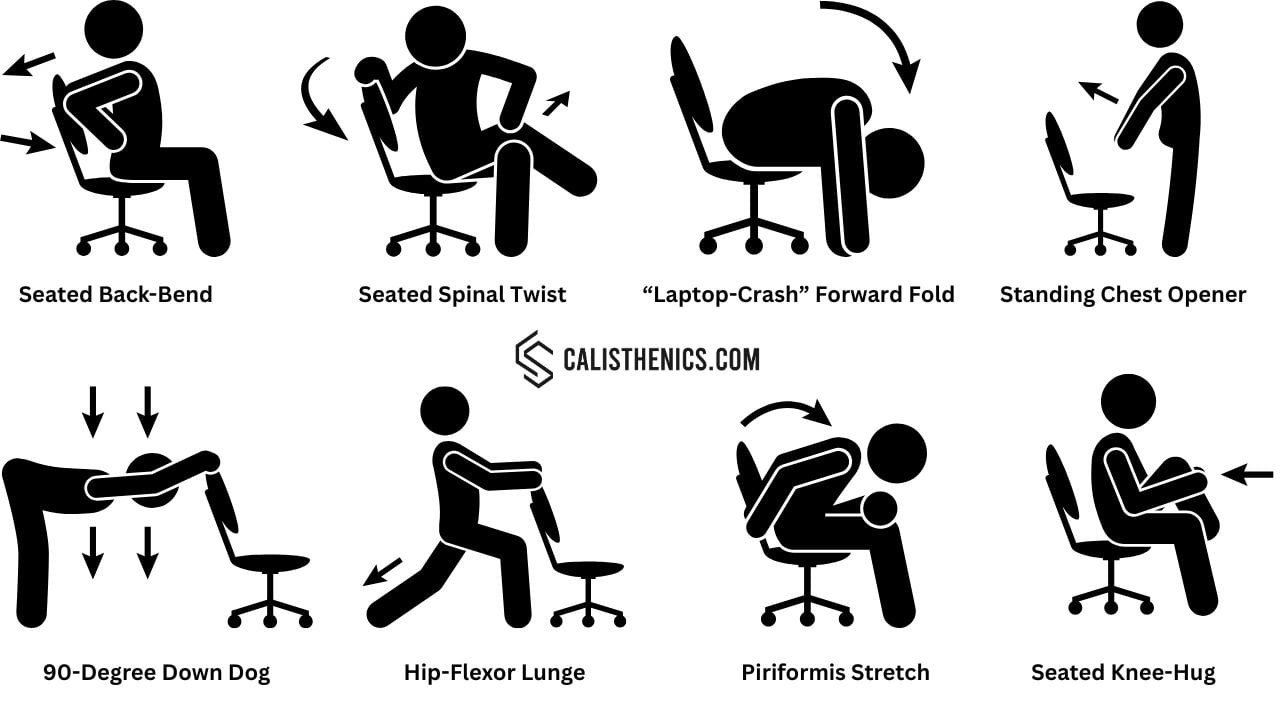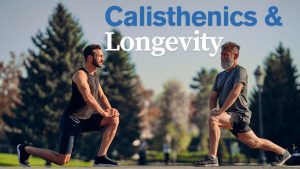I never thought I’d become “that guy” who groans every time he stands up from a chair. I’ve played sport since I could walk and I earn my living showing people how to master pull-ups, planches, and muscle-ups. Yet in my early thirties—right around the time my daily computer work ballooned to six–eight hours—my lumbar spine staged a full-blown rebellion. The paradox hit hard: even with regular calisthenics, I still limped away from the desk with an aching lower back.
If you’re reading this at a workstation, chances are you feel the same dull tug across your belt-line. Research puts concrete numbers behind the anecdote: medical students who sat more than seven hours a day were 1.7 × more likely to report lower-back pain (LBP) than their more active peers. Another trial found that simply cutting sitting time over six months prevented back pain from worsening . Add in anterior-pelvic-tilt-inducing hip-flexor tightness and you have the perfect recipe for desk-driven misery.
A year ago I finally drew a line in the sand. I doubled down on targeted lumbar strengthening (that’s a separate article) and, crucially, I micro-dosed movement through the workday via the eight stretches below. None require equipment, none make you look like you’re auditioning for Cirque du Soleil, and most days my colleagues end up copying me rather than laughing. What follows is the exact routine that now lets me finish marathon writing sessions and still get into a straddle planche without feeling like the Tin Man.
Why Calisthenics Athletes Still Get Low-Back Issues
Even though calisthenics exercises are perfect for building "an invisible corset" by fortifying the core, most calisthenics athletes neglect these movements as boring. Classic “signature” moves—pull-ups, dips, handstands, front levers—hammer anterior-chain muscles and scapular stabilisers but do remarkably little for the lumbar extensors. Over time the abdominals and hip flexors can dominate, pulling the pelvis into posterior or anterior tilt depending on individual biases.
Combine that imbalance with marathon chair-time and you wind up with a spine that’s perpetually flexed, discs weeping under constant pressure, and glutes that forget how to fire (the aptly named gluteal amnesia) . The scientific literature supports loading the spine in extension to restore its natural curve—extension-based rehab outperforms flexion for chronic axial LBP at one-year follow-up —so our stretch arsenal leans heavily in that direction.
The Micro-Dose Philosophy
Instead of saving mobility for a 30-minute “stretch session,” I sprinkle 60- to 90-second “movement snacks” every hour or two. A recent Active-Break protocol showed measurable pain reduction just from these brief interruptions . Think of it as flossing for your fascia: small, frequent, and preventative.
Anatomy Cliff-Notes (So You Know What You’re Feeling)
- Lumbar Extensors (Multifidus, Erector Spinae): Act like guy-wires keeping the spine erect. They fatigue when locked in static flexion.
- Discs & Nucleus Pulposus: Hydrated “jelly doughnuts” that lose water and height under prolonged sitting; decompression plus extension helps imbibe fluid back in.
- Hip Flexors (Iliopsoas, Rectus Femoris): Shorten while you sit, tugging the pelvis forward and increasing lumbar shear.
- Piriformis & Glutes: When tight or inhibited they can torque the sacrum, leading to sciatic-like discomfort.
- Thoracic Spine & Lats: Slouching rounds the upper back; opening this segment frees the lower back from shouldering all extension duties.
Keep those tissues in mind as we move—knowing why a stretch works helps you refine the how.
The Office-Friendly Lower Back Stretch Line-Up
Below you’ll find the eight heroes of my deskbound day. I’ve ordered them roughly from least conspicuous to slightly more space-demanding, so you can deploy the stealth options during meetings and save the bigger moves for coffee breaks.
1. Seated Back-Bend (Hands on Hips)
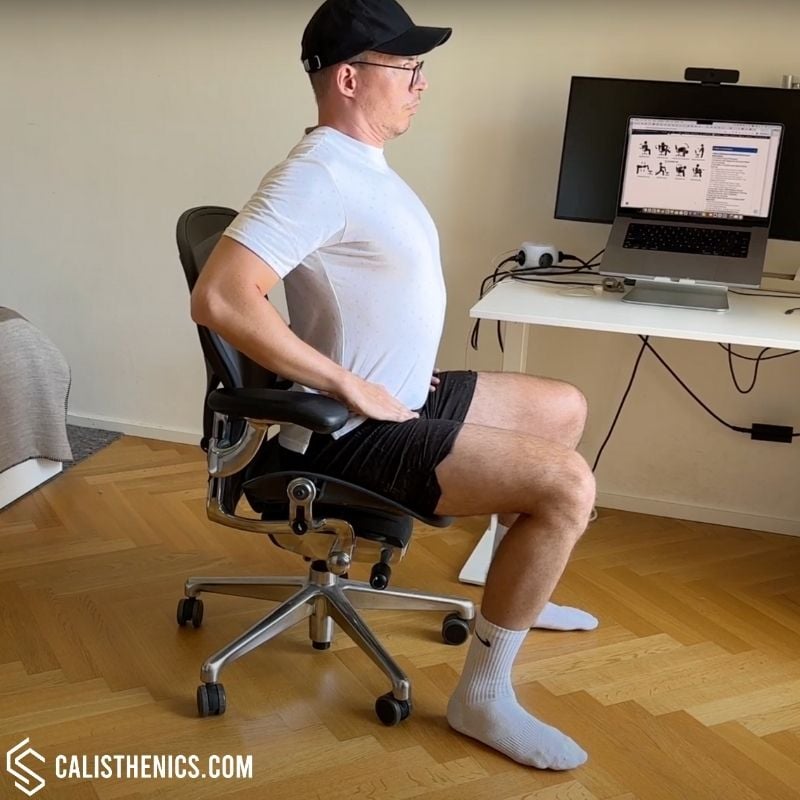
What it is:
I sit tall, plant my feet hip-width, brace both palms into the belt-line, inhale, then gently press my pelvis forward as I lift my sternum and look toward the ceiling. Ten seconds feels magical.
Why it works:
That lumbar extension counters the C-shape slouch and coaxes blood into the erector spinae—exactly the motion shown to reduce axial disc pressure in standing lumbar-extension drills . The slight hip-flexor stretch also mitigates anterior pelvic tilt.
Pro tips:
- Initiate from the hips, not the neck.
- Think “length then arch,” avoiding abrupt hinge points.
- Two–three rounds, 5–10 seconds each.
2. Seated Spinal Twist with Figure-4 Leg

Setup:
Cross right ankle over left thigh. With a tall spine, grab the chair back with the right hand. Inhale; on the exhale rotate right, using the left palm on the knee for leverage. Switch sides.
Feel it:
Thoracic vertebrae gliding, piriformis lengthening, and even a subtle opening across the right groin.
Why bother?
Rotational mobility distributes forces during dynamic skills like front-lever pulls. Plus, freeing the piriformis reduces tension on the sacrum.
Desk hack:
Keep elbows tucked; giant flapping arms look dramatic on Zoom.
3. “Laptop-Crash” Forward Fold
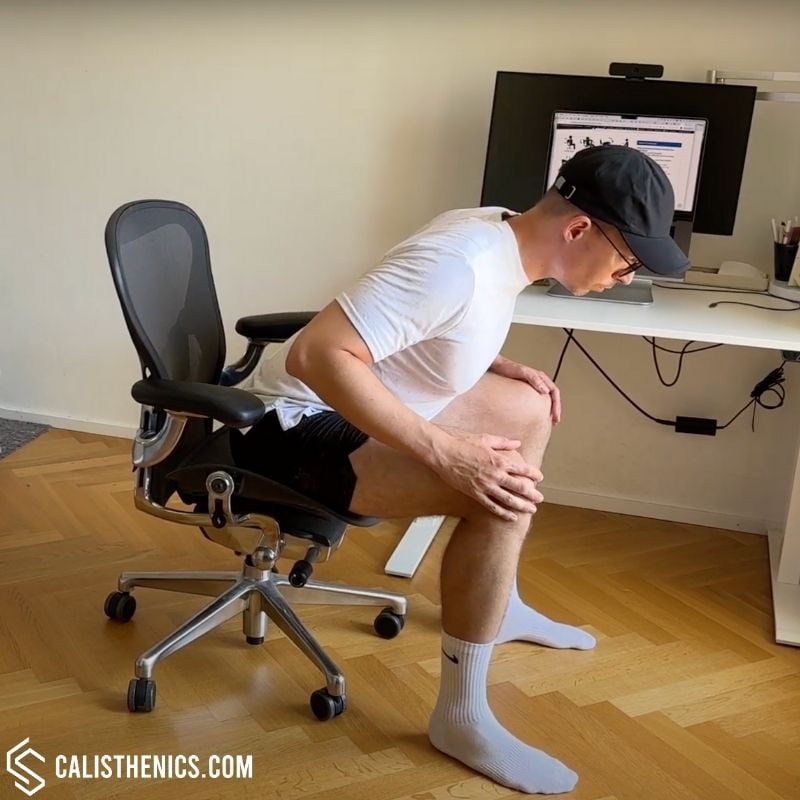
Execution:
Scoot to the chair edge, feet wide, allow the spine to melt over your thighs, arms hanging. Breathe into the balloon of the low back for 30 seconds.
Anatomy angle:
Rounding decompresses posterior spinal elements and hydrates discs after compression. It also grants the thoracolumbar fascia a delicious stretch.
Safety cue:
If you’re disc-injury prone, transition slowly, keeping abs lightly engaged on the return to upright.
4. Standing Chest / Shoulder Opener

Method:
Stand one step behind the chair, hands atop the backrest. Walk feet rearward until arms are straight. Hinge at the hips so the torso drops between shoulders for 20–30 seconds.
Benefit:
You’ll feel pec minor, lats, and even serratus anterior unclenching. Because thoracic extension improves, the lumbar spine needn’t over-extend to keep you vertical—crucial for keyboard hunchers .
Variations:
Drive the palms downward to add triceps lengthening; bend knees to shift more load into upper back.
5. Supported Half-Downward Stretch (“90-Degree Down Dog”)

Setup:
Place palms on the chair seat, step back until your body forms an “L”. Knees soft, hips push back. Add free spinal traction by gently sinking the chest.
Chain reaction:
Calves, hamstrings, glutes, lats—basically the entire posterior chain—get a simultaneous stretch while gravity unloads lumbar discs.
When I use it:
Mid-afternoon energy slump. The mild inversion plus posterior chain revival beats coffee for waking me up.
6. Chair-Assisted Hip-Flexor Lunge
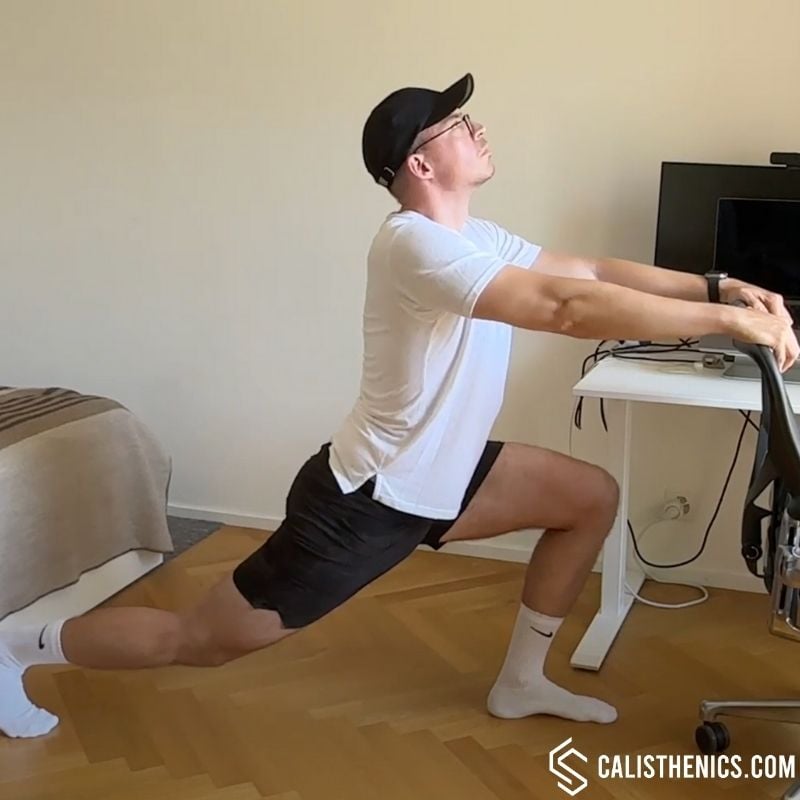
Execution:
Hands on chair for balance. Step left leg back, heel heavy, knee straight. Slightly tuck the tail and glide hips forward until the front of the left hip lights up (20 seconds, each side).
Why it matters:
Tight iliopsoas is a top contributor to desk-induced LBP . Freeing it restores neutral pelvic alignment and reduces shear on L4/L5.
Progression:
Reach the same-side arm overhead and side-bend away to hit the psoas’ upper fibers.
7. Seated Figure-4 / Piriformis Stretch
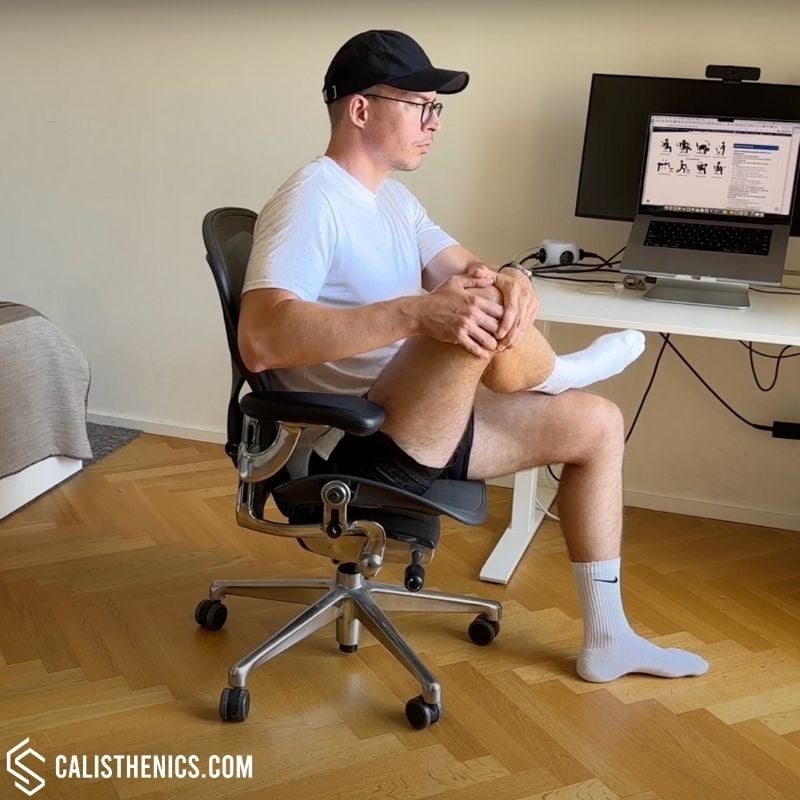
How to:
Back in the chair, cross ankle over knee, flex foot, hinge forward or pull shin toward chest. Breathe for 20–30 seconds.
Feel:
A line across the outer hip/buttock. When piriformis slackens, it stops tugging on the sacrum and irritating the sciatic nerve.
Desk etiquette:
Keep spine long—slouching converts the stretch into a low-value lumbar flexion.
8. Seated Knee-Hug / Cat-Curl
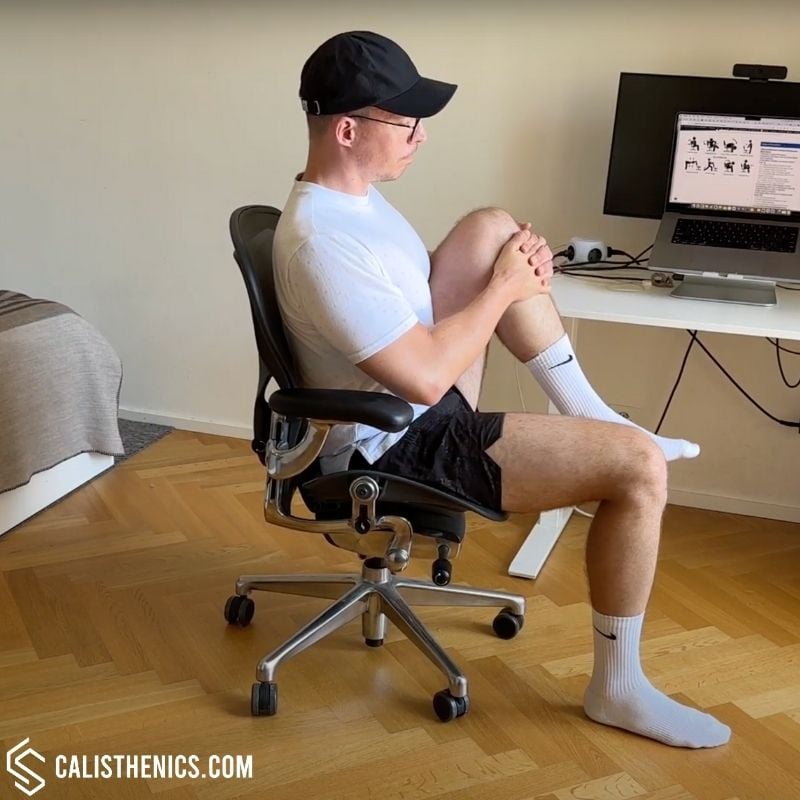
Drill:
Sit back, grasp shins, exhale as you pull knees inward and round the spine. Optional micro-rocking massages paraspinals. Five–ten slow cycles.
Physio rationale:
Provides controlled lumbar flexion after many extension-biased drills, balancing disc loading and smoothing fascia adhesions.
Mindful moment:
Match inhale on release, exhale on curl; the breath-movement pairing doubles as a mini mindfulness reset.
If you prefer to do a follow along version I made a 5 minute video going through the stretches.
A Sample “Work-Shift Mobility Circuit”
I batch the first four stretches at 10:30 a.m. (post-coffee), run 5–7 right after lunch, and finish with the knee-hug before shutting the laptop at 6 p.m. On heavy writing days I sprinkle the seated back-bend every hour—to borrow from McGill, “motion is lotion” for the spine.
| Time | Stretch | Duration |
|---|---|---|
| 09:00 | Seated Back-Bend | 3 × 10 s |
| 10:30 | Twist + Chest Opener | 2 min |
| 12:30 | Half-Downward + Hip-Flexor | 3 min |
| 15:00 | Figure-4 + Forward Fold | 3 min |
| 18:00 | Knee-Hug Cat-Curl | 1 min |
Even at peak “busyness” the entire protocol costs me <15 minutes spread through eight hours—less than the time most of us accidentally burn on social media.
Integrating with Your Calisthenics Training
On pull-up days I tack the hip-flexor lunge and chest opener onto my warm-up so lats and shoulders can glide freely. Post-session I favour the laptop-crash fold to decompress after weighted pull-ups. Keeping the lumbar extensors alert balances the anterior chain dominance that front lever and hollow-body work cultivate.
A fascinating 2024 Nature study demonstrated that extension-pattern rehab restored lumbar lordosis and reduced chronic LBP better than flexion routines . Translating that into calisthenics, dedicating time to active lumbar extension—superman holds, back extensions, prone swimmers—prevents the pancake-flat lower back posture that saps power from planches and handstands.
Personal Results After 12 Months
- Pain scale: From daily 4/10 ache down to a rare 1/10 twinge after long drives.
- Training output: I added 15° to my bridge and ironed out the hollow-back I used to hit at the top of muscle-ups.
- Work focus: Fewer distraction breaks because I’m not adjusting in the chair every five minutes.
- Unexpected perk: Colleagues now nominate me as the unofficial “movement break MC” during team off-sites.
Take-Home Checklist
- Set an hourly phone alarm or use a Pomodoro timer; habit beats willpower.
- Hit at least one extension bias (back-bend or half-downward) every session.
- Pair hip-flexor and piriformis work—free the pelvis from both sides.
- Log what you feel. Pain patterns reveal which stretches you need most.
The Right Office Set Up for Avoiding Lower Back Pain
I used to roll my eyes at standing-desk evangelists—especially my colleague Ben, who ditched his chair completely and bragged that he “sat enough in meetings anyway.” Back then I chalked it up to office theatrics. Fast-forward a few birthdays and a few too many groans as I stood up from my keyboard, and Ben’s “gimmick” suddenly sounded like wisdom.
My Standing Desk Saga
So, about a year ago, I tore down my home office and installed a quiet, push-button sit-stand desk. Now I glide between two presets: writing mode at 96 cm and standing mode at 116 cm. The first week felt gimmicky; by week three I noticed my end-of-day lumbar ache had faded to a whisper. The magic isn’t standing all day—trust me, that gets old fast—it’s moving all day. I follow a loose 30-30-5 rhythm: 30 min sitting, 30 min standing, 5 min strolling or knocking out the back-bend from our stretch list.
If you are curious, I got myself the largest available desk in white on Amazon (affiliate link), and it only cost me $300. The cheapest option is currently $160.

From Exercise Ball to Ergonomic Stool
Pre-desk-upgrade I tried the budget route: bought this 65 cm exercise ball for less than $20 on Amazon. It definitely nudged my core awake, but every time I wanted to sit I had to crank the desk down to its lowest position and then jack it back up to stand. If you don't want a standing desk just yet, I would recommend getting the ball to test the position without back support. As a bonus, the ball doubles as a handy tool for home workouts.
As for me, after a month of that yo-yo, I invested in this height-adjustable saddle stool. Game-changer.
- Ball pros: dirt-cheap, sneaky core work, fun to bounce on during Zoom calls.
- Ball cons: forces a very low desk height. Needs to be pumped up periodically. Rolls into frame during video calls like an escaped planet.
- Stool pros: one lever gives me any seat height I need; slight tilt keeps my pelvis neutral; foot ring lets me off-load when calves protest.
Now I perch on the stool when my legs need a break, then shove it aside with my foot and pop the desk up when I’m ready to stand. Zero momentum lost.

Anti-Fatigue Floor Mat
If you add standing intervals, do your feet (and low back) a favour and grab a ¾-inch foam mat. I bought this ComfiLife mat from Amazon. Without one, my first standing stint ended with fiery soles and a subtle lumbar whine—hard floors are unforgiving. The mat lets my ankles micro-shift, which keeps blood flowing and lumbar muscles from locking up. Look for beveled edges so you don’t trip when you shuffle back to the keyboard.
External Monitor + Laptop Stand Combo
Last tweak: screen height. Nothing torpedoes posture faster than craning down to a laptop. I parked a 24-inch monitor at eyebrow height and travel with a folding laptop riser that boosts my MacBook about 18 cm. I got this ergonomic laptop stand from Amazon, and I'm very happy with it. A cheap wireless keyboard keeps my elbows at 90° even when the screen is sky-high. Neck stops barking, lumbar stays neutral—win-win.
Lower Back Stretching Related FAQs
Do I need to stretch every hour?
The literature suggests that interrupting long sitting bouts matters more than total stretch time*. Aim for at least one mobility snack per hour; if life derails you, make up with a few back-bends during the next coffee refill. *https://pubmed.ncbi.nlm.nih.gov/39707287/
Will these fixes replace strength work?
Nope. Think of stretches as WD-40 and strengthening drills as the wrench that actually tightens your posture. I pair bird-dogs, hip bridges, and Jefferson curls with my pull days. Keep an eye out for my upcoming article detailing those protocols.
I have a herniated disc—safe?
Clear any new routine with a physio. That said, studies show guided lumbar extensions can relieve some disc-related pain*. Start conservatively and avoid stretches that reproduce tingling or sharp pain. *https://www.nature.com/articles/s41598-024-51769-2
Feet go numb during figure-4—normal?
Tingling suggests nerve compression; back off intensity, ensure neutral lumbar, or swap for the knee-hug to calm irritated tissues.
Final Thoughts
Our bodies crave variability. Even the strongest front-lever athlete can end up with a creaky lumbar spine if he forgets to move it outside the sagittal plane—or leaves it parked in flexion for hours on end. The eight office-friendly stretches above restored my spinal mojo and, more importantly, my freedom to sit down or jump into a single-arm handstand without fearing the next morning.
Give the routine four weeks. Track pain levels, energy, and training quality. Shoot me a note with your results, and stay tuned for the strengthening companion piece. Until then, stand up, push your hips forward, take a deep breath, and let that spine know it’s still very much alive.
Move well, live well—right from your swivel chair.

